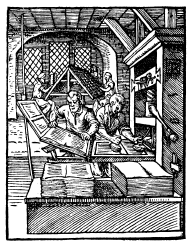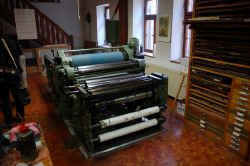|
Printing techniques explained
| Printing techniques used in fine art printing usually come in two varieties; printmaking – where the artists works directly on the printing matrix, or reproductions - where a printed image is faithfully reproduced from another original work.
|
Printmaking
Printmaking normally covers only the process of creating prints where the artists works directly on the printing matrix, such as drawing directly on plates of copper, zinc, or stone in engraving, etching or lithography; cutting into blocks of wood or linoleum for woodcuts and linocuts, or creating fabric screen plates for screen-printing (serigraphy). Since the matrix is affected by the printing method, each piece (or “impression”) produced is considered an original. Also since the matrix usually degrades with each impression such works are usually signed and numbered with the earlier numbers being higher quality and closer the artists original intent. This is what is technically referred to as a “print” in the artistic world.
|

from Wikipedia |
Reproductions
A reproduction is a printed image reproduced from another original source such as a 2-demensional work of art. Usually the artists does not have a hand in making the print (other than approving the final image) since the process is technically complicated and involves specialized knowledge and printing hardware (although this distinction is now blurring since modern digital techniques can allow the artist to control the entire process). Almost all reproductions use the 4-color CMYK printing method that combines blue (cyan), red (magenta), yellow, and black (the “key”) to create a full color image. Some types of reproductions include:
|
|
Collotype
- Developed by French and German printers in the 1860, Collotype is now almost extinct. A printing plate is made for the 4 basic colors by transferring the 4 photographic negatives onto a plate of glass or metal with a substrate composed of gelatin or other colloid and hardening it. Through Collotype, it is possible to create a continuous tone image, making it unique (no dots), as most other processes must break up the image into a series of screen patterns or dots.
4-Color Offset Lithography - The 4-color offset lithography uses the lithographic process, which is based on the repulsion of oil and water, and photo-mechanical imaging, to create four color printing plates. This process has very little input from the artists since it requires specialized equipment (re: an entire printing facility) to make photo-separations and printing plates, not to mention the multi-ton printing presses used for each color. Up until recently, if you saw a reproduction in a print shop or galley, it was a 4-color offset lithograph. 4-color offset lithography has historically been the primary method to produce large run reproduction editions. |

Example of an offset printing press - Wikimedia Commons |
Inkjet Printing - Newer digital inkjet technology is now used to reproduce images in sometimes very large sizes on special fine
art papers — even genuine printmaking or watercolor papers — and on canvas. These printers are the sophisticated big brothers of the standard inkjet printer. Many years of development with print makers, computer scientists, and artists working together went into making these technologies what they are today, a far superior way to reproduce an original work of art. All have the hallmark of allowing artists to take full control of their images through digital image manipulation, including matching colors exactly and choosing substrates on which they are printed. It is even feasible for an individual artist to own their own equipment. Digital inkjet printmaking has earned its reputation as one of the most creative mediums available to working artists. The equipment used to produce these images is not intended for mass production runs like the old giant 4-color litho presses. Signed and numbered inkjet editions usually run under 100 and sometimes under 50 images. The overall expense of this limited edition process, combined with the expensive papers, and the exacting color standards to which artists can (and do) adhere to means these types of images comes at a premium price.
|
|
- Iris prints – The Iris printer was the first digital inkjet technology successfully adapted for fine art printing in the early 1980s. An early developer of the technology in the fine art field was Graham Nash of the band Crosby, Stills, Nash, and Young. He and other printmakers working in the field adapted this color accurate industrial printer to print images on all types of fine art substrates. The Iris printer uses a continuous tone spray of water soluble, dye based inks, which react distinctly to each paper’s surface, allowing a diverse spectrum of intensity and depth. Iris prints are highly sensitive to water, moisture and heat and need to be treated like an original watercolor. The prints are water miscible from both sides. The paper used is 100% cotton rag, which has a HALS/UV protective coating – this imparted a mild waterproofing and improved the appearance by punching up the color, while deepening the blacks. This type of printing is still used for continuous tone printing.
- Pigmented inkjet printers – The current state of the art is printers using 8 to 12 separate colors and highly archival waterproof and fade resistant pigmented inks. The process is a CMYK process but multiple sub-colors are used for each color to achieve an image that is nearly continuous tone in appearance (you need a strong magnifying glass to see the random dot pattern produced by this type of printer). Pigmented inkjet printers have the ability to print on all types of fine papers and canvas. Because of high color quality and archival nature of the inks used, this type of technology
is used to reproduced replicas of artwork for libraries and museums.
- Giclée, Qoro Replica™, Qorograph, Digigraph – These are all coined names or trademark names used by different printers for the Iris or pigmented inkjet based printers and the reproductions they produce.
|
|
Printing and the works of the Wyeths.
When it comes to the works of the Wyeths several things need to be kept in mind. N. C. Wyeth and Andrew Wyeth were never “print makers”. N. C. Wyeth’s illustrations were all intended to be reproduced photo-mechanically, via one, two, or three color process or via 4-color lithography. Andrew Wyeth is exclusively a painter. Consequently any work you see by N. C. or Andrew Wyeth in printed form is technically a reproduction. Jamie Wyeth produces images in reproduction form but he has also done fine art printmaking including etching and lithography. There have been Collotype editions produced by the Wyeth family, namely Triton Press, Inc editions of the works of Andrew Wyeth, Henriette Wyeth, and her husband, Peter Hurd. As for modern inkjet technology, both Andrew and James have created personally approved Iris prints including Iris at Sea by James Wyeth and Southern Comfort and Harlequin by Andrew Wyeth. Both Andrew and James Wyeth have made signed and numbered limited edition pigmented ink editions with various companies. There are also unsigned editions of Andrew and N. C. Wyeth’s work currently being produced in pigmented ink editions. These works are approved and controlled by the Wyeth family. |

Dragonfly by James Wyeth
An example of a pigmented ink
reproduction.
|
|


